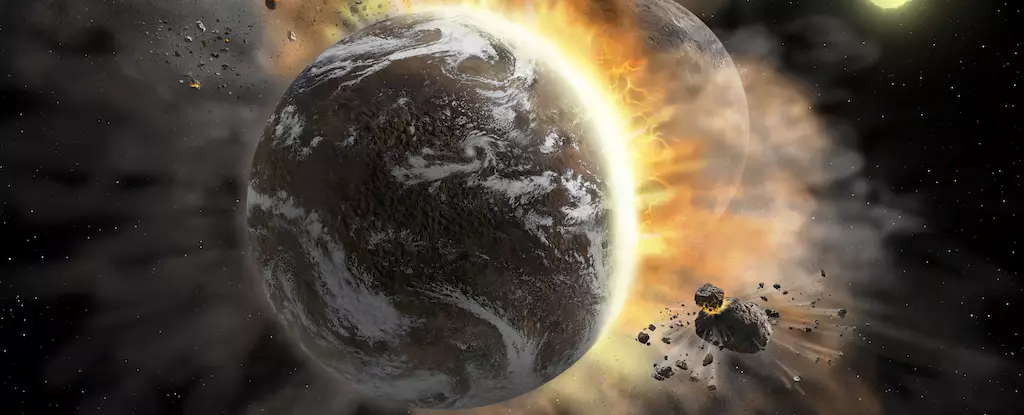At its inception, the Solar System was a maelstrom of cosmic debris, with celestial bodies colliding and merging in a chaotic struggle for dominance. The Moon, with its pockmarked surface, serves as a haunting reminder of this tumultuous past. As we extend our gaze beyond our Solar System, it becomes increasingly evident that the early stages of planet formation elsewhere in the universe must follow a similar narrative. In a recent study, researchers sought to recreate these prehistoric collisions through simulation, targeting the dramatic encounters of gas giants. The results are not only reflective of our understanding of planetary dynamics but also hint at the darker, seismic activities brewing beneath the surface of exoplanets.
The Grand Experiment: Simulating Cosmic Collisions
A team of astronomers has employed sophisticated modeling to simulate a collision between two massive gaseous planets. Central to the research is the notion that giant impacts can generate seismic waves capable of revealing the internal architecture of these colossal bodies. Unlike seismic waves on Earth, which are measurable and informative regarding geological structures, the focus here is on how such waves might affect the light emitted by these distant worlds.
Led by J.J. Zanazzi, a theoretical physicist from UC Berkeley, the study scrutinizes two principal inquiries: the feasibility of long-lived seismic waves resulting from titanic impacts, and the capacity of the James Webb Space Telescope (JWST) to decipher these phenomena. Although the JWST cannot measure seismic waves directly, it can detect minute variations in light, which may be sculpted by seismic activity. This opens new avenues for observing how planets may betray their violent histories through photometric changes.
Tracking Seismic Echoes in Distant Exoplanets
Among the targets of this inquiry is Beta Pictoris b, a nascent exoplanet boasting a mass around 13 times that of Jupiter and a mere 12 to 20 million years in age. Its metallic richness suggests a fusion of materials born from numerous collisions, laying the groundwork for further examination of its seismic properties. The researchers hypothesize that the violent merging of a Neptune-sized body, containing 17 Earth masses, could ignite intense seismic activity within Beta Pictoris b.
The implications of this research are profound. The seismic oscillations instigated by such conflicts could resonate through the planet for millions of years, allowing the JWST to potentially detect changes in luminosity linked to this seismic activity. In practical terms, this means that even after a collision, the echoes of that event can inform astronomers about the planet’s composition and internal dynamics over extensive time frames.
Seismological Insights: Bridging Theory with Observation
Through this innovative approach, the research unveils a promising conceptual framework for utilizing seismology to probe the interiors of gas giants. The authors assert that seismic waves act as a direct conduit into understanding a planet’s internal structure, providing insights into crucial characteristics such as density and composition. In particular, the longest-lasting seismic waves can yield astronomical frequencies that correlate with internal dynamical frequencies, bridging a knowledge gap that has persisted with previous methods such as gravity measurements.
This novel use of seismic data may even extend beyond mere planetary composition studies. The methodology posits that oscillation patterns could be indicative of a planet’s migratory history. For instance, it is suggested that planets like hot Jupiters might bear witness to significant tidal interactions that excite these oscillatory modes, revealing traces of their migratory paths through intricate light curves.
The Future: Cosmic Clarity through Seismic Waves
The prospect of unearthing the hidden intricacies of exoplanet interiors presents a captivating frontier in astronomy. The concept of linking seismic activity to observable photometric changes offers an innovative technique of studying worlds that, until now, lay beyond the technical reach of traditional observational frameworks.
Humanity stands on the cusp of a new understanding of exoplanets, armed with advanced technologies like the JWST. This exploration will not only illuminate the past of the celestial bodies in our own neighborhood but could also enhance our comprehension of distant worlds, revealing stories marked by chaos, creation, and metamorphosis. Each seismic wave detected could represent a breadcrumb in the narrative of planetary development, enriching our cosmic understanding with the whispers of planetary collisions that echo through the epochs of time.


Leave a Reply